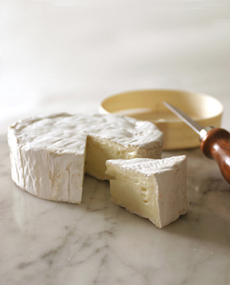
 Cows from Normandy enjoy the ideal terroir for producing great milk. The damp, mild climate and rich volcanic soil produce lush grass and herbs which impart luxurious flavor to the milk. Photo by Evan Dempsey | THE NIBBLE. Cows from Normandy enjoy the ideal terroir for producing great milk. The damp, mild climate and rich volcanic soil produce lush grass and herbs which impart luxurious flavor to the milk. Photo by Evan Dempsey | THE NIBBLE.
|
STEPHANIE ZONIS focuses on good foods and the people who produce them.
|
|
May 2007
Last Updated May 2018
|
 |
Brie Or Camembert:
Page 1: Two Great French Cheeses
This is Page 1 of a four-page article. Click on the black links below to visit other pages.
Overview
Ask anyone about French cheeses, and sooner or later (probably sooner) Brie and Camembert will come up in the conversation. Both are bloomy-rinded, aged (though not for very long) semi-soft fromages, with reputations for being among the crown jewels of French cheeses.
The differences between the two can be subtle, especially to an untrained palate, but this is not remarkable when you consider that Brie and Camembert are made from the same exact “recipe,” a fact unknown to many. The variations in the two come about from their sizes and their different terroirs, a French word meaning something akin to “sense of place.” Often used in wine terminology, terroir accounts for the characteristics a particular geographic region imparts to a food, be it coffee, wine or cheese. But let’s take a closer look. (Also see our separate article, The Differences Between Brie & Camembert.)
Origin Of Camembert
The most common legend about Camembert’s history involves a woman named Marie Harel, a farmer in the village of Camembert, in the Normandy region of France, who was hiding a priest during the French Revolution. Supposedly, Madame Harel invented Camembert in 1791, with the help of the priest she saved from the guillotine.
Despite her heroics, it is more likely that Madame Harel had nothing to do with the cheese’s invention, although she may have improved Camembert with some tip passed along to her by the priest. Camembert was known to exist in the Normandy region as early as 1680. There is some speculation that Camembert may have been a blue cheese originally, and that the cheese’s characteristics changed over time until it evolved into what we know today.
- Curdle. To make Camembert, whole, raw milk from Normandy cows is curdled with rennet, then gently hand-ladled into small, individual molds without breaking the curd. Camembert curd is customarily shaped in disks of 4.5 inches in diameter, 1.5 inches thick, about 8 ounces (250g) in weight. Five ladling passes are necessary to fill each mold; supposedly, this helps give Camembert its creamy texture.
- Mold. The curds are then gently leveled in the mold and the cheeses are allowed to drain for some four or five hours, after which they’re turned over for further draining.
- Salt. The next day, the cheeses are removed from their molds and go into a salting room, where a special “dry” salt (“sel sec,” in French) is applied to them.
|
|

Camembert and its familiar round box, which was invented by an engineer to enable transport of the delicate cheese. Photo courtesy CaviarRusse.com. |
- Coat. The cheeses are then coated with Penicillium candidum mold and placed on shelves to age. During the entire process, the temperature of the milk is not permitted to rise above 98.6°F (37°C). No milk powder or concentrated milk can be added.
The law must be followed to the letter, for a cheese to be called Camembert. Read more about AOC designation, below.
How Camembert Spread Beyond Normandy
Camembert de Normandie, as the genuine article is called, remained a local product until the late 1800s, when a French engineer surnamed Ridel invented the thin, round, wooden boxes in which all Camemberts are now packaged. Camembert’s reputation resulted in increased demand, but the cheeses were fragile and suffered during transport. These boxes made distribution of Camembert to other regions in Europe (via the new steamboats and railway systems) much easier.
Accordingly, production increased as well (other countries began to produce Camembert, too). After World War II, much of Camembert production became industrialized, resulting in a bland, inferior-quality product.
AOC Designation Arrives
Finally, in the 1980s, Camembert was awarded an AOC distinction. AOC stands for “Appellation d’Origine Controlée.” This government designation is a guarantee that any cheese bearing it was made in a specific region using only approved methods of production.
- In other words, real Camembert can only be made in one area of France, via strictly-regulated procedures.
- Confusingly, the name “Camembert” itself is not protected, so you’ll see pasteurized milk “Camembert” sold as well as “Camembert” from both the U.S. and Italy.
Only the raw milk variety has AOC designation; pasteurized Camemberts do not.
Unfortunately for American consumers, true Camembert (always made with raw milk) is simply unavailable in the U.S. Why? It must be made with raw (unpasteurized) milk, and any cheese made with raw milk must be aged at least sixty days before it can be sold in the U.S.
The difficulty is that raw milk Camembert won’t last that long. It’s aged for just two or three weeks and is at its best thirty or thirty-five days after it’s made; this stage of perfect ripeness and ideal eating quality is called “a point” (pronounced ah PWAHN) in France. Sixty-day-old Camembert would look and smell like something a chemical company was trying to hide.
There are pasteurized Camemberts sold in the U.S., and they are tasty. They just lack the range of complexity of the raw milk cheese.
Continue To Page 2: Brie
Go To The Article Index Above
Lifestyle Direct, Inc. All rights reserved. Images are the copyright of their respective owners.

|





